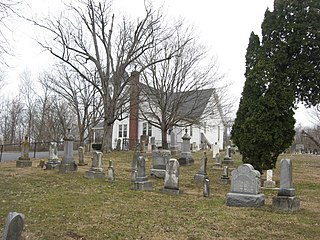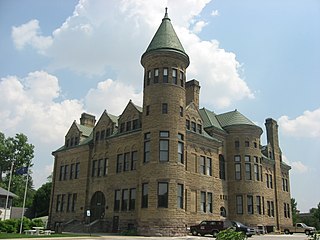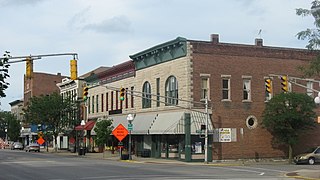
The East Spring Street Historic District is a national historic district located at New Albany, Indiana. The general area is E. Fifth Street to the west, Spring St. to the north, E. Eighth Street to the east, and Market Street to the south. The Cedar Bough Place Historic District is one block north of the area, the New Albany Downtown Historic District is immediately west of the area, and the Market Street section of the Mansion Row Historic District starts. The district encompasses 84 contributing buildings in a largely residential section of New Albany. It developed in the late-19th and early-20th century and includes notable examples of Queen Anne and Italianate style architecture. Notable buildings include the Third Presbyterian Church, St. Mary's Roman Catholic Church and Rectory, the former John Conner House or Masonic Lodge, and Edwards City Hospital.

Bethany Congregational Church or Bethany United Church of Christ is a historic Congregational church located at West Terre Haute, Vigo County, Indiana. It was built between 1907 and 1909, and is a Victorian Gothic-style church built of stone, brick and limestone. It features and octagonal corner bell tower and Gothic arched windows. The architect was Charles Padgett.

St. Vincent Villa Historic District is a national historic district located at Fort Wayne, Indiana. The district encompasses nine contributing buildings and one contributing site associated with a Catholic orphanage. The buildings were constructed between 1932 and 1950–1951, and include notable examples of Mission Revival, Romanesque Revival, and Bungalow / [[AFort Wayne Newspapers American Craftsman]] style institutional architecture. They include the Main Building (1932), four cottages, the Boiler House (1932), and two bungalows. The property was sold by the Roman Catholic Diocese of Fort Wayne–South Bend to the YWCA of Fort Wayne in the 1970s.

The Landing Historic District is a national historic district located at Fort Wayne, Indiana. The district encompasses 18 contributing buildings and 1 contributing structure in the central business district of Fort Wayne. The area was developed between about 1868 and 1943, and includes notable examples of Renaissance Revival, Romanesque Revival, and Italianate style commercial architecture. Located in the district is the separately listed Randall Building. Other notable buildings include the Keystone Block, Fisher Brothers Paper Building (1914), The Bash Building (1895), and The Pinex Company Building (1917).

North Anthony Boulevard Historic District is a national historic district located at Fort Wayne, Indiana. The district encompasses 296 contributing buildings in a predominantly residential section of Fort Wayne, extending along North Anthony Boulevard from Lake Avenue in the south to Vance Avenue in the north. An overlapping designation includes all of the rights of way in the district, plus those on the rest of North Anthony south to the Maumee River, as well as on South Anthony Boulevard south of the river.

Fort Wayne Park and Boulevard System Historic District is a national historic district located at Fort Wayne, Indiana. The district encompasses 34 contributing buildings, 61 contributing sites, 70 contributing structures, and 15 contributing objects in 11 public parks, four parkways, and ten boulevards associated with the parkway and boulevard system in Fort Wayne. The system was originally conceived in 1909 by Charles Mulford Robinson (1869–1917) and further developed and refined by noted landscape architect and planner George Kessler (1862-1923) in 1911–1912. The buildings reflect Classical Revival and Bungalow / American Craftsman style architecture. Later additions and modifications include those by noted landscape architect Arthur Asahel Shurcliff.

Traders Point Eagle Creek Rural Historic District is a national historic district located at Pike Township, Marion County, Indiana, and Eagle Township, Boone County, Indiana. The district encompasses 109 contributing buildings, 40 contributing sites, and 12 contributing structures in a rural area near Indianapolis. The district is characterized by the agricultural landscape, farmsteads and estates, recreational landscapes, transportation features including roads and bridges, and historic cemeteries.

Traders Point Hunt Rural Historic District is a national historic district located at Eagle Township, Boone County, Indiana. The district encompasses 34 contributing buildings, 18 contributing sites, and 7 contributing structures in a rural area near Zionsville. The district is characterized by the agricultural landscape, farmsteads and estates, recreational landscapes, transportation features including roads and bridges, and historic cemeteries.

Point Historic District is a national historic district located at Logansport, Cass County, Indiana. The district encompasses 34 contributing buildings, 2 contributing sites, and 1 contributing structure in the heart of the oldest section of Logansport. It has a mix of residential and commercial buildings and notable examples of Queen Anne and Colonial Revival style residential architecture. Notable contributing resources include the Urban Point Park, Firestone Station (1928), All Saints Rectory, St. Joseph's Roman Catholic Church (1884), Geiger Building (1889), and St. Luke's English Evangelical Lutheran Church (1908).

Courthouse Historic District is a national historic district located at Logansport, Cass County, Indiana. The district encompasses 79 contributing buildings and one contributing site in the central business district of Logansport. It has a mix of institutional, governmental, and commercial buildings and notable examples of Late Victorian and Romanesque Revival style architecture. Notable contributing resources include the Masonic Hall (1896), Elks Lodge No. 66 (1907), Douglass Building, McCaffey Building, Logansport-Cass County Public Library (1942), The State Theater, United States Post Office (1925), Bank Building, and Watts Building (1901).

Brazil Downtown Historic District is a national historic district located at Brazil, Clay County, Indiana. The district encompasses 35 contributing buildings and two contributing objects in the central business district of Brazil. The district developed between about 1875 and 1935, and includes notable examples of Italianate, Romanesque Revival, and Renaissance Revival style architecture. Located in the district is the separately listed United States Post Office. Other notable buildings include the Sinclair Oil Gas Station, Lark Theater, Citizens Bank Building, Brazil Trust Company, D.H. Davis Building (1909), and Telephone Building.

Meridian–Forest Historic District is a national historic district located at Brazil, Clay County, Indiana. The district encompasses 220 contributing buildings and 13 contributing structures in a predominantly residential section of Brazil. The district developed between about 1866 and 1940, and includes notable examples of Italianate, Romanesque Revival, and Queen Anne style architecture. The district is characterized by brick streets and alleys. Notable buildings include the First Methodist Church, First Presbyterian Church, Masonic Lodge, Carnegie Library, and Brazil Junior High School.

Old Frankfort Stone High School, also known as Old Stoney, is a historic high school building in Frankfort, Clinton County, Indiana. It was built in 1892, and is a 2 1/2-story, Richardsonian Romanesque style sandstone building on a raised basement. It has Indiana limestone trim, a large round arched entrance, four large stone chimneys, and four-story corner tower with a tall conical roof. The building was damaged by fire in 1922, and rebuilt with the work completed in 1926. The building housed a junior high school from 1962 to 1974, after which it ceased use as a public school.

South Frankfort Historic District is a national historic district located at Frankfort, Clinton County, Indiana. The district encompasses 151 contributing buildings and 1 contributing structures in a predominantly residential section of Frankfort. The district developed between about 1875 and 1940, and includes notable examples of Italianate, Queen Anne, Colonial Revival, and Bungalow / American Craftsman style residential architecture. Notable buildings include the Hammersley Building, First Baptist Church (1912-1913), and Masonic Temple (1912).

The Hedden's Grove Historic District is a national historic district located at New Albany, Indiana. The district encompasses 43 contributing buildings and 2 contributing structures in a suburban residential section of New Albany. It developed between the 1920s and 1950s, and includes notable examples of Colonial Revival, Tudor Revival, Bungalow / American Craftsman, and Ranch style residential architecture.

North Vernon Downtown Historic District is a national historic district located at North Vernon, Jennings County, Indiana. It encompasses 80 contributing buildings and 1 contributing structure in the central business district of North Vernon. The district developed between about 1852 and 1955, and includes notable examples of Federal, Italianate, Classical Revival, and Bungalow / American Craftsman style architecture. Notable contributing buildings include the First Christian Church, M.T. Lindley Building (1891), N.C. Bank, Masonic Lodge (1899), Red Man Lodge #99, Jennings County Carnegie Library (1920), Bantz Building, Ades Building (1913), Perry-Verbiage Building, Couchman Building, and Gottwalles Grocery (1893).

Winchester Residential Historic District is a national historic district located at Winchester, Randolph County, Indiana. The district encompasses 142 contributing buildings, 1 contributing site, and 1 contributing structure in a predominantly residential section of Winchester. The district developed between about 1837 and 1950 and includes notable examples of Greek Revival, Italianate, Romanesque Revival, Colonial Revival, Prairie School, and Classical Revival style architecture. Notable buildings include the First Presbyterian Church of Winchester (1903), Winchester Friends Church (1897), First United Methodist Church (1900), Main Street Christian Church (1912), First Church of the Nazarene (1929), Carey Goodrich House (1858), Kizer-Marsh House, and W.E. Miller House (1910).

East Washington Street Historic District is a national historic district located at South Bend, St. Joseph County, Indiana. It encompasses 71 contributing buildings and 1 contributing structure in a predominantly residential section of South Bend. It developed between about 1880 and 1947, and includes notable examples of Italianate, Colonial Revival, American Foursquare, and Bungalow / American Craftsman style architecture and works by architects Austin & Shambleau. Notable buildings include the James and Marie Zimmerman House (1921), Eger House (1911), George and Emma Hewitt House (1905), Ruth and Edwin H. Sommerer House (1930), Chauncey T. Fassett House (1898), Dougdale Carriage Barn (1900), and Sunnyside Presbyterian Church.

Twelve Points Historic District is a national historic district located at Terre Haute, Vigo County, Indiana. It encompasses 12 contributing buildings in a suburban commercial district of Terre Haute. It developed between about 1905 and 1954, with most built between 1890 and 1920, and includes representative examples of Commercial, Art Deco, and Classical Revival style architecture. Notable buildings include the Twelve Points State Bank (1919), People State Bank (1923), Twelve Points Hotel (1908), and Garfield Theater / Harmony Hall (1939).

Irvington Terrace Historic District is a national historic district located at Indianapolis, Indiana. It encompasses 578 contributing buildings and 9 contributing sites in a planned residential section of Indianapolis. The district developed between about 1895 and 1959, and includes representative examples of Tudor Revival, Colonial Revival, and Bungalow / American Craftsman style residential architecture.
























